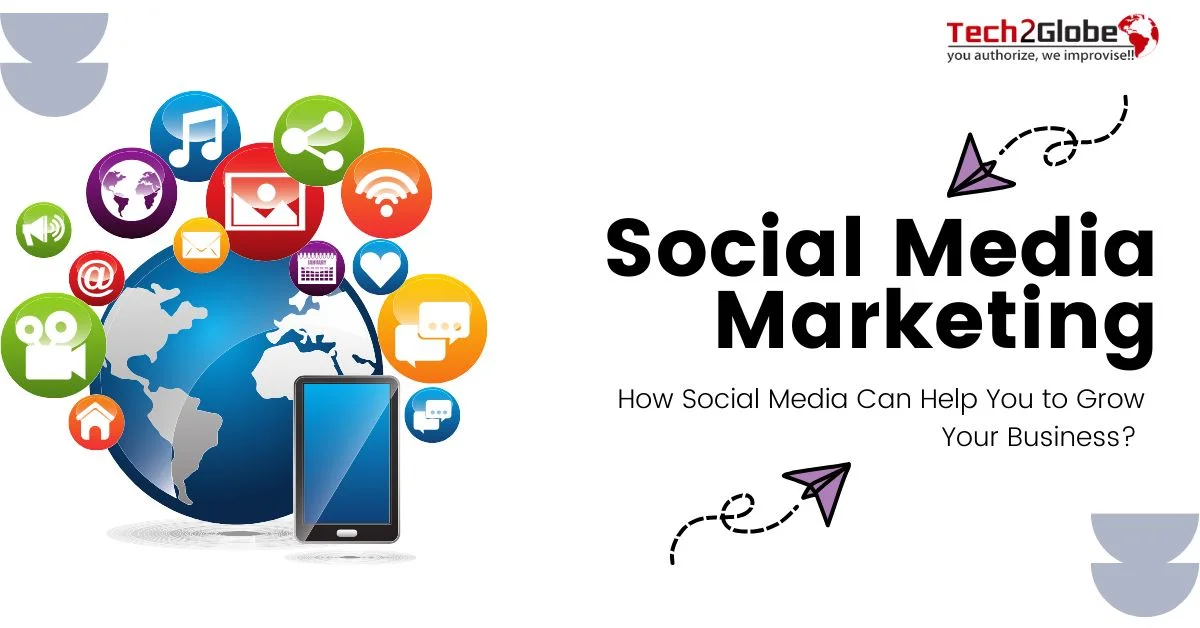BUSINESS
How Social Media Can Help You to Grow Your Business?

The social media space is on a roll! Performance data in January 2024 issued by Datareportal states that more than half of the global population (an overwhelming 62.3%) is now active on social media platforms. That’s 5.04 billion people, with a fascinating statistic of 266 million new social media users who joined in a year! Also, people spend an average of 2 hours and 23 minutes daily on social media for content consumption is something that one can’t ignore.
As such, the social media hype has earned a lot of interest among business owners, but how can they effectively utilize the medium’s potential to their benefit? This is where SMO services come in full force. Strategically using social media platforms is the cornerstone of SMO services to enable them to achieve the business goals of the particular organization. This can be done by creating enticing content, handling campaigns for social media advertising, and cultivating relationships with the audience.
Let’s explore how social media can affect your business in various directions.
How to Use Social Media to Grow Your Business?
Social media marketing is synonymous with digital marketing or e-marketing in essence. These two terms all aim to bring businesses to their potential audiences using several online communication channels. It sets up analytical data processing, enabling the gathering of in-depth statistical data characterizing consumer demand for products, services, or methods.
Online platforms allow enterprises to post helpful information, seek their competitors and get to know them, promote their brand, engage in E-commerce by taking online sales, and eventually, fast-track long-term business expansion. Metrics from social media are insightful because they present information such as customer data, audience engagement, referrals, and conversions, which can all be used to enhance brands and tips. Brands can perform in real-time online mode by real-timing the heads comparison.
Business Branding
Social media platforms are ideal platforms for brands to convey their products’ services and information. Brand identity is the visual signifier expressing the organization’s vision, mission, and values. The corporate logo is the most pronounced graphic that creates a distinct image from rivals. The company principle or mission statement provides an insight into its ideals and values. With brand identity, consumers form relationships with the company’s pioneers, employees, designers, and chief officers, a powerful tool for small business owners.
Consistent Posting
Consistent blogging or posting is essential for getting the most out of your internet presence. Create a content calendar to schedule communications for your audience routinely. The algorithms underpinning each platform change constantly, but the more material you create, the more platforms will promote it to ever-larger audiences. This often entails publishing daily for at least 30 days at a time.
Customer Engagement
Engaging with your clients extends beyond simply posting material. You can communicate with your audience directly by leaving comments, liking, sharing, and sending messages. Marketing methods such as live videos, Q&A sessions, and freebies can help you build a personal connection with your audience, which can lead to sales. Respond to internet interest by replying quickly to comments and communications.
Lead Generation
Social networking is an excellent approach to find new customers who could be interested in your product. You may attract them with innovative or informative content, and then turn them into customers. Social media allows you to test ideas with audiences before investing money in new products or services.
Paid Advertising
Paid ads on any platform are invaluable tools to help small businesses grow. They attract a high volume of shoppers to a store or certain websites, bring up sales figures, and facilitate strategic ads designed for a particular age group. It offers cost-efficiency, where a budget of $1 a day for the same period can herald the beginning. Yet, that is not to say that it must be the end of the road for business entities trying to employ sophisticated marketing strategies or those with difficulty optimizing their ad campaigns. Instead, it might be beneficial, in such cases, to work with a marketing consultant, such as Tech2Globe, who can offer expertise in several areas that go beyond simply running ads.
Conclusion
Social media gives a game-changing chance to those companies that are either small or large. When you tap into the multi-faceted power of the medium, you can create brand visibility, establish solid connections with the audience, and turn interactions into sales opportunities. Thus, seize the social media marketing opportunity and witness your brand growth.
Remember, Tech2Globe, a data processing services company along with social media marketing specialists, can be your trusted partner in going through these fast-changing digital spaces. For further information on Tech2Globe’s SMO services, get in touch with Info@Tech2Globe.com.
BUSINESS
Integremos: Revolutionizing Business Integration in the Digital Era

The digital landscape is evolving rapidly, and businesses worldwide are seeking innovative solutions to streamline their operations. One such solution gaining prominence is “Integremos,” a comprehensive integration approach that promises to revolutionize how businesses operate in the digital era.
Introduction
In the fast-paced world of technology, the term “Integremos” has been gaining momentum as a game-changer for businesses seeking seamless integration across their various functions. But what exactly is Integremos, and why is it crucial in today’s digital age?
Integremos refers to a holistic approach to integration, encompassing the amalgamation of various processes, technologies, and systems within a business. It’s about creating a unified and interconnected environment that fosters collaboration, enhances efficiency, and ultimately propels a business towards success in the digital era.
Understanding Integremos
Core Concepts and Principles
At its core, Integremos is built on the idea of breaking down silos within an organization. It involves the integration of disparate systems, processes, and technologies to create a cohesive and interconnected ecosystem. By doing so, businesses can eliminate redundancies, streamline workflows, and create a more agile and responsive infrastructure.
Application in Various Industries
Integremos isn’t limited to a specific industry. Whether in healthcare, finance, manufacturing, or any other sector, the principles of Integremos can be applied to enhance operational efficiency. The adaptability of Integremos makes it a versatile solution for businesses across diverse domains.
Benefits of Integremos
Efficiency and Productivity Improvements
One of the primary advantages of Integremos is the significant improvement in efficiency and productivity. By integrating systems and automating repetitive tasks, employees can focus on more strategic and value-driven activities, leading to increased overall productivity.
Cost-Saving Aspects
Integremos can also contribute to cost savings by reducing manual errors, minimizing operational redundancies, and optimizing resource utilization. Businesses adopting Integremo’s often witness a notable decrease in operational costs, making it a cost-effective solution in the long run.
Enhanced Collaboration and Communication
The integration facilitated by Integremos fosters improved collaboration and communication among different departments. When data flows seamlessly across the organization, decision-making becomes more informed, and teams can collaborate more effectively, leading to enhanced overall performance.
Implementing Integremos in Business
Step-by-Step Guide
Implementing Integremos requires a strategic approach. Businesses can follow a step-by-step guide, starting with a thorough assessment of existing systems and processes. Identifying key integration points and creating a roadmap for implementation is crucial for a smooth transition.
Real-Life Examples of Successful Integration
To illustrate the practical application of Integremos, examining real-life examples of businesses that have successfully implemented this approach is enlightening. Case studies provide insights into the challenges faced, strategies employed, and the tangible benefits achieved through Integremos.
ALSO READ: THE POWER OF ACCOUNTABILITY – ACHIEVING SUCCESS WITH A BUSINESS COACH
Challenges and Solutions
Common Obstacles in Implementing Integremos
While Integremos offers numerous benefits, businesses may encounter challenges during implementation. Common obstacles include resistance to change, compatibility issues, and data security concerns. Addressing these challenges head-on is essential for a successful integration process.
Strategies to Overcome Challenges
Strategies such as effective change management, thorough training programs, and robust security measures can help businesses overcome challenges associated with Integremo’s implementation. Proactive problem-solving ensures a smoother transition and sets the stage for long-term success.
Integremos in SEO
Impact on Search Engine Rankings
In the age of digital marketing, businesses are keenly aware of the importance of SEO. Integremo’s can have a significant impact on search engine rankings by optimizing website performance, ensuring mobile responsiveness, and improving overall user experience.
Best Practices for SEO Integration
Integrating Integremos into SEO strategies requires a thoughtful approach. Best practices include optimizing website speed, implementing structured data, and ensuring seamless integration with analytics tools. These practices not only improve SEO but also contribute to a better user experience.
Future Trends of Integremos
Emerging Technologies and Their Influence
The future of Integremo’s is closely tied to emerging technologies. Artificial intelligence, machine learning, and blockchain are just a few examples of technologies that will shape the evolution of Integremo’s. Businesses should stay informed about these trends to remain competitive in the digital landscape.
Predictions for the Future of Integremos
Predicting the future of Integremos involves anticipating how technological advancements will impact integration processes. From enhanced automation to more sophisticated data analytics, the future holds exciting possibilities for businesses embracing Integremo’s.
ALSO READ: UNVEILING CUBVH: WHERE INNOVATIONS SOAR AND INSPIRATIONS IGNITE
Case Studies
Successful Businesses Leveraging Integremos
Examining case studies of successful businesses leveraging Integremos provides valuable insights into the practical applications of this integration approach. Companies across industries have achieved remarkable outcomes by strategically implementing Integremo’s to enhance their operations.
Measurable Outcomes and Success Stories
Measurable outcomes, such as increased revenue, improved customer satisfaction, and enhanced operational efficiency, showcase the tangible benefits of Integremo’s. Success stories from businesses that have effectively integrated Integremo’s into their operations serve as inspiration for others considering this approach.
Integremos vs. Traditional Approaches
A Comparative Analysis
Comparing Integremo’s with traditional approaches highlights the advantages and disadvantages of each. While traditional methods may be deeply ingrained in some organizations, the benefits of Integremo’s in terms of efficiency, agility, and adaptability are compelling reasons for businesses to consider a shift.
Advantages and Disadvantages of Both Methods
Understanding the advantages and disadvantages of both Integremo’s and traditional approaches allows businesses to make informed decisions. Factors such as scalability, flexibility, and cost-effectiveness play crucial roles in determining the most suitable integration strategy.
Security Considerations
Addressing Concerns Related to Data Security
Data security is a paramount concern in the digital age. Businesses must prioritize robust security measures when implementing Integremos to safeguard sensitive information. Encryption, access controls, and regular security audits are essential components of a comprehensive security strategy.
Ensuring a Safe Integration Process
Ensuring a safe integration process involves collaboration between IT professionals, data security experts, and stakeholders. Businesses should develop and implement protocols that prioritize data integrity and confidentiality throughout the integration journey.
Integremos and Data Analytics
Utilizing Integrated Data for Analytics
Integrated data sets created through Integremo’s provide a goldmine of information for data analytics. Businesses can leverage this integrated data to gain valuable insights into customer behavior, market trends, and overall business performance, empowering data-driven decision-making.
Improving Decision-Making Processes
Informed decision-making is a cornerstone of successful business operations. Integre mos not only facilitates the collection of diverse data but also ensures its accuracy and accessibility. This, in turn, improves decision-making processes, empowering businesses to stay ahead in a competitive landscape.
ALSO READ: NAVIGATING EFFICIENCY: A DEEP DIVE INTO PEOPLETOOLS ATT
User Experience with Integremos
Enhancing Customer Satisfaction
A seamless user experience is vital for customer satisfaction. Integremos contributes to a positive user experience by ensuring smooth interactions across various touchpoints. From online transactions to customer support, businesses can create a more satisfying experience for their customers through Integre mos.
Providing a Seamless Experience
The integration of systems and processes by Integre mos leads to a seamless experience for both internal and external users. Whether it’s employees navigating through different software applications or customers interacting with online platforms, Integre mos ensures a cohesive and user-friendly experience.
Training and Adoption
Training Employees for Integremos Adoption
Successful Integremos implementation requires the active involvement and understanding of employees. Training programs should be designed to familiarize staff with the new integrated environment, emphasizing the benefits and providing hands-on experience to ensure a smooth transition.
Strategies to Encourage Widespread Use
Encouraging widespread use of Integremos involves fostering a culture of innovation and collaboration within the organization. Recognizing and rewarding successful integration efforts, providing ongoing support, and showcasing the positive impact of Integre mos are key strategies to promote adoption.
Continuous Improvement
Regular Updates and Upgrades
The digital landscape is dynamic, and businesses must adapt to stay competitive. Regular updates and upgrades to Integre mos ensure that businesses are equipped with the latest features and functionalities. This commitment to continuous improvement is vital for sustained success.
Staying Current with Evolving Technologies
As technology evolves, so does the landscape of integration solutions. Staying current with evolving technologies ensures that businesses can harness the full potential of Integre mos. This proactive approach positions organizations to capitalize on emerging trends and maintain a competitive edge.
Conclusion
In conclusion, Integremos stands as a transformative force in the digital era, offering businesses a holistic approach to integration. From enhancing efficiency and productivity to improving user experience and decision-making processes, Integre mos has the potential to reshape how businesses operate.
As we look ahead, the future of Integre mos holds exciting possibilities with the integration of emerging technologies. Businesses that embrace this approach, learn from successful case studies and address challenges proactively are poised for long-term success in the ever-evolving digital landscape.
ALSO READ: ASSUMIRA UNVEILED: TRANSFORMING DIGITAL EXPERIENCES
FAQs
What is Integremos?
Integremos is a holistic integration approach that connects various business processes, technologies, and systems to enhance efficiency and collaboration.
How can Integremos improve operational efficiency?
By integrating disparate systems and automating tasks, Integremos streamlines workflows, reduces redundancies, and boosts productivity.
What are the key benefits of implementing Integremos?
The main benefits include improved efficiency, cost savings, enhanced collaboration, and a more agile business infrastructure.
What are common challenges in adopting Integremos?
Challenges may include resistance to change, compatibility issues, and data security concerns, which can be mitigated with effective strategies.
How does Integremos impact SEO and user experience?
Integremos enhances SEO by optimizing website performance and user experience, leading to better search engine rankings and customer satisfaction.
BUSINESS
10 Tips For Planning a Commercial Building Renovation

Introduction:
Starting to renovate a business building is like starting a journey: you need to carefully plan your route, have a clear idea of where you want to go, and have a reliable map to help you get there. It can be hard to figure out how to redesign an office, a store, or an industrial building. Don’t worry, though! This comprehensive guide is your reliable partner, giving you clear instructions and useful information to help you handle all the challenges of your Commercial Building Renovation project.
1. Assessing Needs and Goals
Before you start renovating a business building, you need to know why you’re doing it and what you want to achieve. In this case:
Understanding the Purpose of Renovation: Before making commercial building renovation plans, it’s important to know why the job is being done. Are you trying to bring the building up to date, make it more useful, or make it look better? Knowing the reason for the makeover will help you make decisions along the way.
Identifying Key Objectives and Priorities: After figuring out the renovation’s purpose, it’s time to set clear goals and order of importance. This could mean doing things like making better use of room, updating infrastructure, or meeting compliance standards. Setting these goals in order of importance makes sure that resources are used well.
2. Budgeting and Financing
To finance the renovation of a commercial building, you need to carefully weigh the costs and funding choices available:
Estimating Costs and Expenses: First, list all the costs and fees you expect to have for the renovation. This includes things like labor, supplies, permits, and fees for professionals. For making a reasonable budget, it’s important to get the costs right.
Exploring Financing Options: Once you know how much the renovations will cost, look into your choices for paying for the project. This could mean getting loans, looking for business partners, or using money from inside the company. Picking the right financing choice is important to make sure the project stays within its means.
3. Legal and Regulatory Considerations
To ensure compliance and avoid possible failures, it’s important to know how to navigate the legal and regulatory landscape:
Obtaining Necessary Permits and Approvals: Get all the permits and approvals you need from the local government before you start any renovations. This could include things like building permits, zoning approvals, and environmental clearances. Not getting the right licenses can cause delays and fines that cost a lot of money.
Compliance with Building Codes and Regulations: Make sure that the renovation job follows all applicable safety, building, and regulatory rules. This includes following the rules for structure, electricity, plumbing, and mobility. Working together with legal counsel and regulatory experts can make it easier to deal with tricky compliance problems.
4. Hiring Professionals
Building a skilled team of professionals is crucial for the success of a commercial renovation project:
Selecting an Architect and Design Team: Work with a skilled architect and design team to come up with ideas that match your goals and vision for the renovation. Pick professionals who have worked on business projects before and have a creative way of designing things.
Hiring Contractors and Subcontractors: Choose contractors and subcontractors with good reputations to do the remodeling work quickly and well. You should make sure that they have the skills and experience that are needed for your job. A relationship needs to be able to communicate clearly and trust each other.
If you live in Sacramento, CA, collaborating with Boulevard Construction for high-quality Commercial Building Renovation services is a wise decision. Boulevard Construction is known for its experience and dependability, and it provides customized refurbishment solutions.
Boulevard building works with Red Hawk, which specializes in 24/7 CCTV surveillance services for construction zones. Their innovative technology ensures continuous site surveillance, preventing theft, vandalism, and equipment idle concerns. Boulevard Construction and Red Hawk work together to ensure smooth project execution while effectively meeting the different needs of their customers. With this formidable cooperation, you can be confident that your Commercial Building Renovation project in Sacramento will be handled expertly.
5. Creating a Timeline
Making a realistic schedule is important for managing the renovation project well:
Establishing Milestones and Deadlines: Divide the remodeling project into manageable steps and give each one a reasonable due date. This gives a plan for how things will go and makes it easy to keep an eye on project deadlines. Demolition, building work, installations, and finishing touches are all examples of milestones.
Anticipating Potential Delays and Challenges: Renovation projects often have problems and delays that were not planned for, even when they are well thought out. Plan for problems that might come up, like bad weather, problems in the supply chain, or problems with the law, and include backup plans in the timeline. Being able to bend and change is important for getting past unexpected setbacks.
6. Structural Assessment
It is important to check the building’s structural stability in order to find any underlying problems:
Evaluating the Condition of the Building: Perform a thorough inspection of the building’s structural parts, such as the base, walls, roof, and support systems. Find any signs of damage, wear and tear, or structural problems that might need to be fixed during the makeover.
Addressing Structural Issues and Concerns: Once structural problems are found, work with engineers and building experts to come up with solutions and make any repairs or additions that are needed. To make the building safer and more stable, structural changes might include fixing the foundation, making the walls stronger, or replacing the roof.
7. Design and Layout
A good renovation starts with a design that is both useful and nice to look at:
Developing a Functional and Aesthetic Plan: Work with the design team to come up with a makeover plan that looks good and works well. Think about things like how you use the room, how well your workflow works, your brand, and how your customers feel. Try to come up with a design that makes the commercial area look better and be easier to use.
Incorporating Sustainable and Energy-Efficient Features: Adopt sustainable design principles and include energy-saving features in your plans for renovations. This could include lights, HVAC systems, insulation, and materials that can be used again and again. Sustainable design not only has less of an effect on the environment, but it also lowers prices and makes people more comfortable.
8. Material Selection
Choosing the right materials is essential for achieving durability, performance, and cost-effectiveness:
Choosing Durable and High-Quality Materials: Choose materials that will last, can handle being bent, and can be used in business settings. Take into account things like strength, durability, upkeep needs, and how it looks. Purchase high-quality materials that can stand up to daily use and help the renovated area last a long time.
Balancing Cost and Performance: Quality is important, but it’s also important to think about efficiency, budget, and the cost of the materials. Look into value engineering and other cost-effective options that will still meet the needs of the project without lowering the standard. Give priority to materials that are the best mix of long-lasting, useful, and affordable.
9. Communication and Collaboration
Communication and teamwork that work well are necessary for a project to go smoothly:
Maintaining Open Channels of Communication: Encourage everyone involved in the renovation job to talk to each other in an open and honest way. Set up regular ways to share comments, updates, and progress reports. Get everyone on the team to participate and give their opinion so that problems can be fixed quickly and the project stays on track.
Coordinating Efforts Amongst Team Members: Make sure that architects, contractors, subcontractors, suppliers, and other project players know what they need to do and how to do it. Make jobs, expectations, and deadlines clear so that everyone is on the same page with the project goals. Encourage people to work together and as a team to solve problems and achieve goals.
10. Safety and Risk Management
To protect workers, residents, and the project itself, safety must come first:
Implementing Safety Protocols and Procedures: To lower the chance of accidents and injuries on the job site, make and follow thorough safety rules and guidelines. Give all of your staff the right training, safety gear, and information about safety. Check the work spot often for possible dangers and take care of any safety issues right away.
Mitigating Risks During the Renovation Process: Find out what risks and dangers the renovation job might bring, like unstable structures, dangerous materials, or environmental issues. To deal with these problems before they happen, make risk reduction strategies and backup plans. Be alert and flexible to deal with risks you didn’t expect and make sure the makeover goes smoothly and safely.
Conclusion:
In conclusion, planning a renovation for a business building is a complicated process that needs careful thought, teamwork, and smart decisions. Project stakeholders can overcome problems and reach their renovation goals by figuring out their needs and goals, making a good budget, following the law, putting together a skilled team, setting a realistic timeline, checking the structure’s integrity, designing carefully, choosing the right materials, communicating well, and putting safety first. Commercial renovations can turn old areas into modern, useful, and environmentally friendly places that meet the needs of both the people who live there and the people who have a stake in the project.
ALSO READ: 25PR.COM
Frequently Asked Questions (FAQs):
1. Why should I renovate my commercial building?
Many good things can come from renovating a commercial building, such as bringing old areas up to date, making it more useful, making it look better, raising the property value, attracting tenants or customers, following the rules, and lowering costs by making energy-efficient improvements.
2. How do I determine if my commercial building needs renovation?
Outdated design or amenities, poor usefulness, inefficient use of space, structural problems, safety concerns, code violations, falling occupancy rates, or changes in business needs or industry standards are all signs that your commercial building may need to be renovated.
3. What factors should I consider when budgeting for a renovation?
When making a renovation budget, you should think about the amount of work that needs to be done, the cost of materials and labor, professional fees, permits and approvals, funding options, and emergency funds in case costs come up out of the blue, and the desired return on investment (ROI).
4. How can I finance a commercial building renovation?
You can use your own money, loans from banks or the Small Business Administration (SBA), business mortgages, investor partnerships, crowdfunding, or loans from banks or the SBA to fix up a commercial building.
5. What legal and regulatory considerations are involved in a commercial renovation?
For a commercial renovation, legal and regulatory issues to think about include getting the right permits and approvals, following building codes, zoning laws, environmental laws, accessibility standards, historic preservation rules, and contractual obligations with tenants or stakeholders.
6. How do I select the right professionals for a commercial renovation project?
When hiring professionals for a commercial renovation, look for architects, designers, engineers, contractors, subcontractors, and consultants who have worked on similar projects before, have the right licenses and certifications, and have good references or reviews.
7. How long does a commercial building renovation typically take?
How long it takes to renovate a commercial building relies on many things, including the size and complexity of the project, the amount of work that needs to be done, the availability of materials and labor, the weather, getting permission from the government, and any delays that were not planned for. It can take anywhere from a few months to over a year to do renovations.
8. How do I ensure safety during a commercial renovation?
To make sure everyone is safe during a commercial renovation, you should follow thorough safety protocols and procedures, give workers the right training and personal protective equipment (PPE), do regular safety checks, get rid of any potential dangers, and follow all occupational health and safety laws.
9. What are some common challenges faced during a commercial renovation?
Problems that often happen during business renovations include going over budget, being late, making changes to the design, finding unplanned structural problems, problems with the supply chain, government rules, trouble communicating, disagreements with stakeholders, and managing a lot of different contractors and subcontractors.
10. How can I maximize the ROI of my commercial building renovation?
To get the best return on investment (ROI) from a commercial building renovation, focus on making changes that raise the property value, bring in new tenants or customers, make the building more energy efficient, lower running costs, follow the rules, make the building look better from the street, and fit with long-term business goals and market trends.
REAL ESTATE
Best Online Real Estate School in New York and How to Become a Real Estate Agent NYC

The real estate industry in New York is both dynamic and competitive, offering lucrative opportunities for those who are willing to put in the effort to succeed. Whether you’re looking to start a new career as a real estate agent or seeking to advance your skills and knowledge in the field, choosing the best online real estate school is a crucial first step. Additionally, understanding the process of how become a real estate agent NYC is essential for aspiring professionals.
Importance of Choosing the Best Online Real Estate School
Flexibility in Scheduling
One of the primary benefits of online real estate schools is the flexibility they offer. Whether you’re balancing work, family, or other commitments, online courses allow you to study at your own pace and on your own schedule.
Quality of Education
Not all online real estate schools are created equal. It’s essential to choose a reputable institution that offers high-quality education and comprehensive coursework designed to prepare you for success in the real estate industry.
Accreditation and Licensing
When selecting an online real estate school, it’s crucial to ensure that the institution is accredited and recognized by the appropriate governing bodies. This accreditation not only ensures the legitimacy of the program but also enables you to obtain the necessary licensing to practice as a real estate agent in New York.
Factors to Consider When Choosing the Best Online Real Estate School in New York
Accreditation and Licensing
Before enrolling in any best online real estate school in new york program, verify that the school is accredited by organizations such as the New York Department of State Division of Licensing Services.
Course Offerings
Look for a school that offers a comprehensive curriculum covering all aspects of real estate, including sales techniques, property management, and legal regulations.
Instructor Quality
The expertise and experience of the instructors can significantly impact the quality of your education. Choose a school with knowledgeable and experienced faculty members who are actively engaged in the real estate industry.
Flexibility and Convenience
Consider your schedule and learning preferences when selecting an online real estate school. Look for programs that offer flexible scheduling options and intuitive online platforms for ease of use.
Reviews of the Best Online Real Estate Schools in New York
Top-rated Online Schools
Several online real estate schools have earned accolades for their quality of education, flexibility, and student support services.
Comparison of Features and Benefits
Compare the features and benefits of each online real estate school to determine which best aligns with your educational and career goals.
Steps to Become a Real Estate Agent in NYC
Education Requirements
To become a licensed real estate agent in New York, you must complete a 75-hour pre-licensing course from an accredited institution.
Licensing Process
After completing the pre-licensing course, you must pass the New York real estate salesperson exam and submit a license application to the Department of State.
Continuing Education
Once licensed, real estate agents in New York must complete continuing education courses to renew their licenses every two years.
Tips for Success in the Real Estate Industry in New York
Networking
Building a strong network of clients, colleagues, and industry professionals is essential for success in the competitive real estate market of New York.
Market Knowledge
Stay informed about current market trends, property values, and legal regulations to better serve your clients and make informed business decisions.
Customer Service Skills
Providing exceptional customer service is key to establishing a positive reputation and generating repeat business in the real estate industry.
Conclusion
Choosing the best online real estate school and understanding the process of becoming a real estate agent in NYC are crucial steps towards a successful career in the dynamic and competitive real estate market of New York. By selecting a reputable institution, completing the necessary education and licensing requirements, and honing your skills and expertise, you can position yourself for success in this thriving industry.

 TECHNOLOGY4 months ago
TECHNOLOGY4 months agoBlog Arcy Art: Where Architecture Meets Art

 ENTERTAINMENT2 weeks ago
ENTERTAINMENT2 weeks agoExploring the Kristen Archives: A Treasure Trove of Erotica and More

 LIFESTYLE4 months ago
LIFESTYLE4 months agoThe Disciplinary Wives Club: Spanking for Love, Not Punishment

 LIFESTYLE2 weeks ago
LIFESTYLE2 weeks agoWho Is Sandra Orlow?

 GENERAL3 days ago
GENERAL3 days ago5 Factors That Affect Tattoo Removal Success

 ENTERTAINMENT8 months ago
ENTERTAINMENT8 months agoYuppow: Your Free Source for Movies and TV Shows

 ENTERTAINMENT1 week ago
ENTERTAINMENT1 week agoKiss KH: The Streaming Platform Redefining Digital Engagement and Cultural Currents

 HOME IMPROVEMENT5 days ago
HOME IMPROVEMENT5 days agoGet Your Grout to Gleam With These Easy-To-Follow Tips












